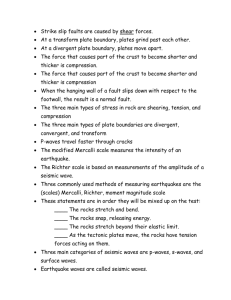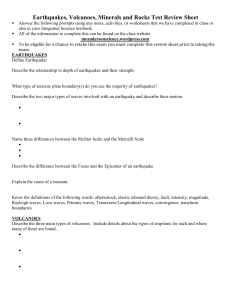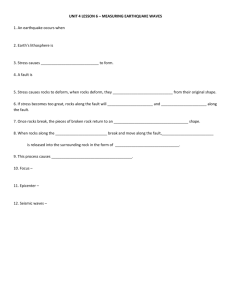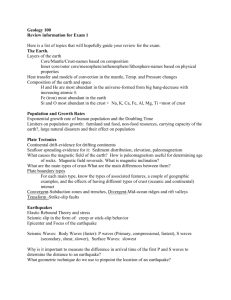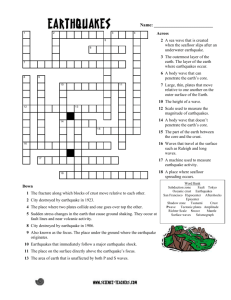A review sheet - The College of New Jersey
advertisement
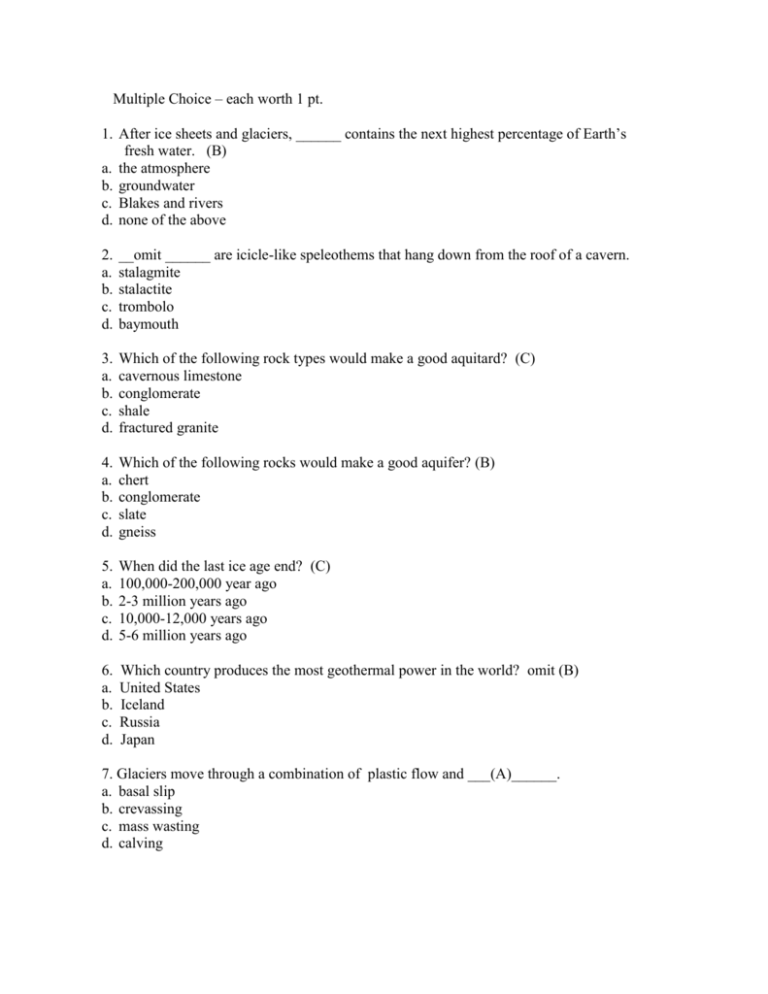
Multiple Choice – each worth 1 pt. 1. After ice sheets and glaciers, ______ contains the next highest percentage of Earth’s fresh water. (B) a. the atmosphere b. groundwater c. Blakes and rivers d. none of the above 2. a. b. c. d. __omit ______ are icicle-like speleothems that hang down from the roof of a cavern. stalagmite stalactite trombolo baymouth 3. a. b. c. d. Which of the following rock types would make a good aquitard? (C) cavernous limestone conglomerate shale fractured granite 4. a. b. c. d. Which of the following rocks would make a good aquifer? (B) chert conglomerate slate gneiss 5. a. b. c. d. When did the last ice age end? (C) 100,000-200,000 year ago 2-3 million years ago 10,000-12,000 years ago 5-6 million years ago 6. a. b. c. d. Which country produces the most geothermal power in the world? omit (B) United States Iceland Russia Japan 7. Glaciers move through a combination of plastic flow and ___(A)______. a. basal slip b. crevassing c. mass wasting d. calving 8. Where is the world’s largest continental ice sheet? (D) a. Iceland b. Siberia c. Greenland d. Antarctica 9. a. b. c. d. Which of the following is necessary for the development of karst topography? (omit) arid climate limestone bedrock saltwater intrusion subsidence 10. A _____(C)____ forms when a stagnant chunk of glacial ice melts after being buried by drift. a. tarn b. esker c. kettle d. drumlin 11. A wide and deep but slow moving stream would generally have (B) a. low competence and low capacity b. low competence and high capacity c. high competence and low capacity d. high competence and high capacity 12. ____(A)____ describes the total sediment load transported by a stream. a. capacity b. discharge c. competence d. hydraulic load 13. A ___(B)____ stream pattern can be found here in central New Jersey where we have gently undulating topography and well developed stream drainage. a. radial b. dendritic c. trellis d. rectangular 14. Where is erosion concentrated along a meandering stream? (B) a. on the straight channel segments that connect the meander loops b. on the outer parts of the meander loops c. at the inner banks of the meander loops d. none of the above 15. Stream terraces will develop if (omit) a. sediment supply to the stream increases b. base level is lowered c. discharge decreases d. a dam is built downstream 16. Which of the following tends to be most porous in an undeformed state? (C) a. shale b. siltstone c. sandstone d. granite 17. which of the following tends to be most permeable in an undeformed state? (omit) a. arkose b. limestone c. quartzite d. basalt 18. The tendency of minerals to break along smooth flat surfaces is called _(D)__. a. fracture b. conchoidal c. streak d. cleavage 19. The idea of that the Earth’s surface was formed in a cataclysmic way by forces that no longer operate is known as________(C)________. a. superposition b. uniformitarianism c. catastrophism d. creationism 20. The typical rate at which tectonic plates move is____(D)______. a. 0.1 inches/year b. 10 inches/year c. 15 inches/year d. 2 inches/year 21. The lithosphere is composed of____(B)________. a. the crust b. the crust and upper mantle c. the upper mantle d. the athenosphere 22. The type of bonding when electrons are shared between atoms is called ___(A)_____. a. covalent b. plutonic c. ionic d. nucleaic 23. The building block of silicates minerals is called the _____(C)_______. a. silicon-cxygen octahedron b. silicon-aluminum tetrahedron c. silicon-oxygen tetrahedron d. none of these 24. Which of the following is a common dark silicate mineral? (C) a. muscovite b. potassium feldspar c. olivine d. quartz 25. Which of the following is the most important factor that contributes to the viscosity of magma? (B) a. temperature of the magma b. amount of silica present in the magma c. amount of volatiles dissolved in the magma d. none of the above 26. ____(A)______ is the most common mineral in the Earth’s continental crust a. Quartz b. Feldspar c. Granite d. Clay 27. The most important factor affecting the texture of an igneous rock is the ___(C)_____. a. water content b. starting temperature c. rate of cooling d. final temperature 28. Magma with ____(A)_____ composition tends to form at divergent plate boundaries. a. mafic b. intermediate c. felsic d. none of the above 29. A ___(B)____ volcano is built almost exclusively from lava fragments and is the smallest type of volcano. a. shield b. cinder cone c. composite cone d. stratovolcano 30. A destructive mudflow that is associated with a volcanic eruption is called a _(C)____. a. nue’e ardente b. pyroclastic cloud c. lahar d. Aa 31. Mount St. Helens is a ___(A)_______ type of volcano? a. composite cone b. shield c. cinder cone d. caldera 32. A what kind of volcanoes to you tend to find at a hot spot located above a mantle plume like in Hawaii? (B) a. composite cone b. shield c. cinder cone d. caldera 33. A glassy texture indicates (A) a. Very rapid cooling b. Very slow colling c. both slow and rapid cooling d. none of these 34. According to Bowen’s reaction series, igneous rocks with ___(C)_____ composition tend to form last from a cooling body of magma. a. Mafic b. Intermediate c. Felsic d. Ultramafic 35. An aphanitic, dark colored igneous rock is called a (A) a. basalt b. gabbro c. rhyolite d. obsidian 36. Submarine volcanic eruptions along mid-ocean ridges generally result in the formation of ____(B)____. a. block lava b. pillow basalts c. lahars d. pyroclastic lava domes 37. The Himalayas and Appalachian mountain chains are examples of mountain ranges that formed (B) a. where and oceanic and continental plate collided b. where two continental plates collided c. Where two oceanic plates collided d. along a transform plate boundary 38. Clay minerals formed from feldspars in bedrock illustrate what kind of weathering? (B) a. mechanical b. chemical c. soluble d. tropical 39. Pressure release weathering results in ___(A)______. a. exfoliation domes b. columnar joints c. regolith d. dissolution 40. Pedalfers develop (B) a. in arid regions b. in humid regions c. in tropical regions d. None of the above 41. ___(B)______ sandstone contains abundant feldspar, suggesting that the sand was derived by mechanical weathering of granitic bedrock a. Quartz-rich b. Arkose c. Oolitic d. Graywacke 42. Which of the following is not a clastic sedimentary rock? (D) a. sandstone b. greywacke c. coquina d. chert 43. A well sorted sediment might consist of (B) a. small-ish grains of a variety of sizes b. larger grains of approximately all the same size c. predominantly round grains of different sizes d. predominantly angular grains 44. Frost wedging in the mountains produces what type of material? (A) a. talus b. conglomerate c. exfoliation d. regolith 45. Which of the following is a type of evaoporite? (D) a. chalk b. coquina c. travertine d. gypsum 46. The intensity of regional metamorphism may be recognized by (C) a. Index polymorphs b. Index fossils c. Index minerals d. Index crystals 47. Which of the following forms at the highest grade of regional metamorphism? (B) a. hornfels b. gneiss c. schist d. phyllite 48. What platy, parallel minerals are commonly found in foliated metamorphic rocks? (C) a. feldspars b. quartz c. micas d. calcite 49. Which of the following is not a limestone? (B) a. oolitic b. sylvite c. coquina d. micrite 50. Which of the following operates primarily in areas of permafrost? (omit) a. b. c. d. solifluction soil creep rock avalanche mudflow 51. How do cycles of freezing and thawing contribute to soil creep? omit a. The soil becomes much weaker when dry and frozen b. Gravity exerts a much stronger force when the soil is wet and thawed c. The soil expands and contracts, lifting particles and dropping them slightly downslope d. None of the above 53. Assume you have just examined several flat-laying sedimentary layers. After much study, you determine that there is a considerable span of time for which no sedimentary rock layer exists at the site. You have just discovered a(n) ___(B)_____. a. angular unconformity b. disconformity c. nonconformity 54. Mass wasting is most likely to occur (omit, B) a. in bedrock b. in an area with steep angles c. where there is a lot of vegetation d. where it is humid 55. Metasomatism occurs (B) a. When an intrusive igneous body bakes nearby bedrock b. When fluids help to produce an exchange of ions in a metamorphic rock c. When rocks get buried under many layers of sediment at the bottom of a lake bed and they begin to metamorphose d. When rocks metamorphose around an active fault zone 56. Carbon-14 dating is used to measure (D) a. The age of relatively old igneous rocks (> 70,000 years) b. The age of relatively old fossils (> 70,000 years) c. The age of relatively young igneous rocks (< 70,000 years) d. The age of relatively young fossils (< 70,000 years) 57. In what climatic conditions is frost wedging most effective? (D) a. in areas that are arid and always cold b. in areas that are wet and always cold c. in areas that are arid and temperate d. in areas that are wet and temperate 58. When an earthquake occurs, energy radiates in all directions from its source. The source is also referred to as the ______(B)______. a. epicenter b. focus c. seismic rebound d. hypopoint 59. Which of the following waves would you expect to arrive first at a seismic station? (A) a. P waves b. S waves c. Surface waves 60. Which of the following waves would you expect to cause the most damage during an earthquake? (C) a. P waves b. S waves c. Surface waves 61. On a seismogram, which of the following waves would show the highest amplitudes? (B) a. P waves b. S waves c. Surface waves 62. Approximately how much more energy is released by an earthquake with a magnitude of 7 than one with a magnitude of 6? (omit, B) a. 10 times b. 30 times c. 100 times d. 3 times 63. _________ refers to the tendency for a ground material to lose its internal cohesion and fail mechanically during earthquake shaking. (A) a. Liquefaction b. Amplification c. Mass wasting d. Rebounding 64. Over 75% of the earthquakes that happen every year occur ___(F)___. e. around the Atlantic Ocean f. around the Pacific Ocean g. around the Indian Ocean h. in the interior of the continents 65. Deep ocean trenches are surficial evidence for ____(B)______. a. rifting of two oceanic plates at a mid-ocean ridge b. sinking of oceanic lithosphere at a subduction zone c. rising hot mantle near a hot spot d. none of the above 66. Seamounts ___(B)_______. a. are composite cone volcanoes formed at ocean-ocean subduction zones b. are shield volcanoes that form on the ocean floor c. form only in the Pacific Ocean basin d. are next to submarine canyons 67. An example of one of the strongest intraplate earthquakes to occur in the United States is (C) a. the 1906 San Francisco earthquake b. the 1964 Anchorage, Alaska earthquake c. the 1811 New Madrid, Missouri earthquake d. the 1783 Northern New Jersey earthquake 68. The sediment on the sea floor that is composed of the skeletons of organisms that secrete CaCO3 is called (D) a. siliceous ooze b. pelagic clay c. manganese nodules d. calcareous ooze 69. The igneous rock that makes up the vast majority of the mantle is (C) a. basalt b. olivine c. peridotite d. gabbro 70. The boundary between the crust and the mantle is called (omit, C) a. D’’ b. the Lehman discontinuity c. the Moho discontinuity d. B’’ 71. Any one type of seismic wave will vary in its actual velocity depending on (B) a. the length of the route it has taken b. the type of material it traveled through c. the depth of the earthquake rupture d. none of the above 72. Isostasy predicts that (omit) a. the continental crust is thinnest beneath mountainous regions b. the continental crust is thickest beneath mountainous regions c. the oceanic crust is thinnest beneath an island arc d. none of the above 73. In order for a tsunami to occur there needs to be (B) a. an underwater earthquake b. displacement of the sea floor c. an underwater volcano d. a subduction zone 74. When rocks are strained elastically, they will ___(A)___ when the pressure is released. a. bounce back into their original shape b. undergo folding c. undergo faulting d. undergo jointing 75. According to elastic rebound theory (D) a. Rocks will bend before they break b. Rocks will snap back into their original shape after bending c. Rocks will break when their capacity to store energy has been exceeded d. All of the above 76. Which of the following operates primarily in areas of permafrost? (omit) a. solifluction b. soil creep c. rock avalanche d. mudflow 77. Mass wasting is most likely to occur (omit, B) a. in bedrock b. in an area with steep angles c. where there is a lot of vegetation d. where it is humid 78. When waves approach the shoreline, they tend to ___(A)______. a. increase in height and decrease in velocity b. increase in velocity and decrease in height c. stay the same height and increase in wavelength d. stay the same height and decrease in velocity 79. The movement of water parallel to the beach is called a ____(A)_____ current. a. longshore b. rip c. turbidity d. drift 80. If you find yourself in a rip current, you should __(C)__. a. swim as quickly as possible to shore over the shortest route possible b. float with the current until it dies out c. swim parallel to the shore for a short distance and then towards shore d. find the longshore current
